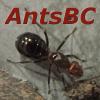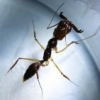Mealworms
Mealworms are easy to care for, produce no odours and cannot climb plastic. Enjoyed by small pets like hamsters, wild birds, and, of course, ants.
There are two easy methods to culturing mealworms.
Bedding: (the bedding is the mealworms primary food source)
bran (can mix in some oatmeal if you want)
Bran is easily found in most grocery and bulk food stores and is quite cheap.
Mealworms have very efficient digestive systems and are able to obtain almost all of their water through their food (their bedding). A slice of apple or potato every week or so is welcome, but remove the leftovers within 12 hours to avoid mold.
Mealworms are actually beetle larvae, one adult beetle can lay 300 eggs. The life cycle takes about 2-3 months depending on the temperature.
Mealworm pupae are often removed from the main container as the mealworms themselves may eat the pupae looking for moisture.
Method One:
You will need a large plastic container, about twice the size of a shoebox. Place 4-6” of bedding in the container. Add 3-4 layers of crumpled up cheap brown paper towel on top of the bedding in one corner (cheap brown coffee filters work as well). Dampen the paper towel once a week, this provides all of the moisture the mealworms could ever want. If it starts to mold, replace the paper towel and water less.
Because of the added moisture and large space, there is no need to seperate the pupae or beetles. They will readily breed.
If you want a higher survival rate, place pupae in a new container. This will also negate the need to try to separate 8mm long mealworm babies when the old medium is expired.
I like to put a small lid on a small container inside of the mealworm container. I put the pupae on the lid and once the beetles emerge they crawl off of the lid and fall to the bedding below, and the remaining pupae are still safe from the odd cannibalistic mealworm or beetle.
Replace the bedding when the mealworms consume 90% of it. If the container is clear, you can see their droppings on the wall as a grey dust/pellets. The dropping sink and the bran rises to the top.
Tip: A kitchen seive works well to strain out beetles, pupae, and all but the smallest mealworms. I strongly advise wearing a dust mask, and possibly fully enclosed safety glasses.
Method Two:
Any size of container, even a small sandwich container will work. Add 1-2 inches of bedding. Whenever you see any pupae, move them to a separate container because in confined spaces mealworms will likely eat the pupae.
Once the beetles emerge, add them back to the container for the cycle to continue. Or you can add them to a new container.
The old bedding is mostly droppings, and is a grey color. Very different in appearance from the fresh bran.
Considering how much of the bedding that they eat over their life cycle, if using a smaller container, it is useful to move the pupae and beetles into a new tub for them to lay eggs in. Then we will not have to sift the young mealworms out of the old bedding.
Note: there have been some reports of pupae having problems eclosing where the bedding is more than half oatmeal.
My Setup:
By the time I move my mealworms to a bin with fresh bedding I get about 2 cups full of squirming mealworms. This is despite feeding numerous colonies.
Materials:
Large plastic shoe box (24" x 14" x 10")
5-6" of bran bedding (I have had much better success after going 100% bran bedding and completely skipping oats)
Egg carton pieces or crumpled up paper towel in one corner
The beetles hang out in the carton or in the paper towel, and usually only venture out to lay eggs or to explore a bit. This helps keep the eggs from being eaten. Beetles love to eat the eggs and young larvae, which is why it is good to have a large container and several inches of bedding. I never move my pupae or beetles unless I am starting a second culture, with all that bedding, most of the pupae survive to eclosing with no issues.
I occasionally toss in an apple core or carrot. If I don't add any fruit/veggies then I will lightly mist the bin once every 2 weeks (I have a fairly tight lid). If I start to see condensation, I open the lid and let it air out until I no longer see condensation when it has been closed.
I have noticed that oats are much more prone to mold than bran is, another reason to avoid oats altogether and go with bran.
Edited by Crystals, October 22 2015 - 11:39 AM.






















